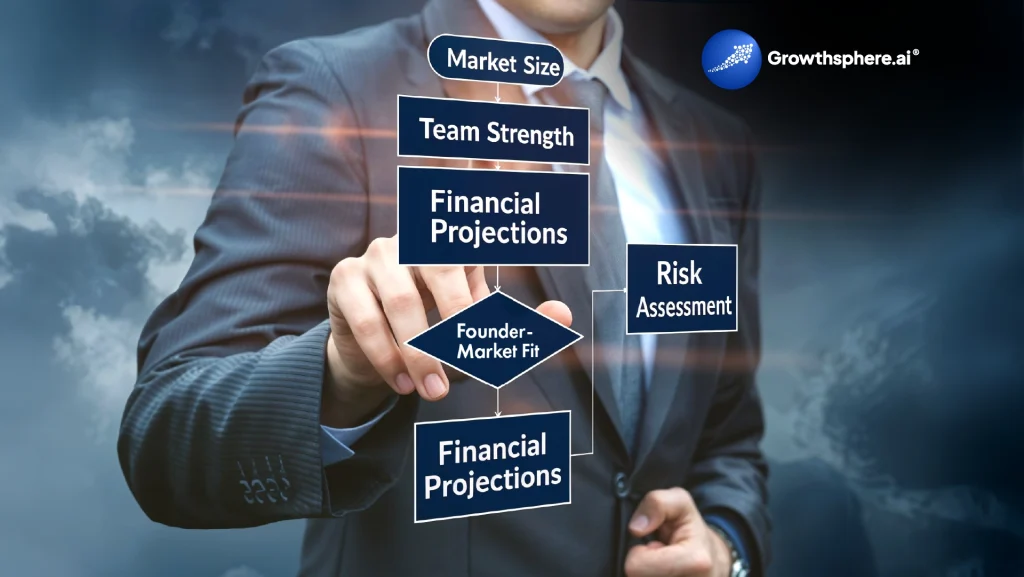A new technique for screening memos for early-stage deals
AI is reshaping every occupation on the planet and the world of early-stage venture investing is no exception. Our initial experiments to help early investors started in late 2023 by seeing how far we can get with clever prompting on both Chat GPT and Claude and the initial results appeared to be good until we showed the results to real VCs.
The problem appeared to be lack of data
Early-stage deals come with almost no data. As a result, pre-seed investing and seed investing invest predominantly in founders. In fact, Growthsphere dismissed this initial use case as viable because of lack of data. As we spoke to more and more VCs, we realized that early investors look at hundreds of deals and the “founder bias” is a significant problem resulting in a massive glut of “spray and pray” of pre-seed investment capital. This model of writing SAFE checks for a few $100K and hoping that real companies emerge is more Darwinian than practical.
The real problem
The real problem turned out to be more nuanced and required considerable work. It wasn’t the lack of data; rather, it was the improper mapping of a company to a sector. Understanding the sector within which a company operates is a critical initial step when evaluating its future prospects. This then drives incremental analysis around the company’s future prospects based on the market’s growth rate and size, competitive (current and future) forces, and the uniqueness of the company’s value proposition.
The industry standard GICS framework provides a good starting point. But it lacks the deeper sector granularity required for analyzing investment opportunities. Company databases like Pitchbook, CB Insights, Tracxn, and Harmonic have employed various approaches to create granular sectors but haven’t been successful when trying to identify reliable competitors. In response, market maps have become fairly widespread and have proliferated especially with increased VC attention, however, they lack consistency, making it difficult to assess the landscape.
Consistent sector mapping is the answer: Enter segmentation ontology
At Growthsphere, after analyzing 10K companies, we created a rich segmentation ontology of companies. An ontology is a structured framework for organizing knowledge, defining concepts, relationships, and categories within a specific domain. The segmentation ontology is a structured framework to categorize sectors. Typical early-stage companies will fall within 1-2 sectors. As an example, Growthsphere is segmented into ‘Investment Decision Making’ as well as ‘Investment SaaS’. The former is the primary category but the latter enables the former.
After 18 months of painstaking effort to originate human-curated categories, we have created nearly 700 new entities that expand upon the GICS framework (~300 entities) but expand deeply into sub-sectors, totaling ~1000 sectors and sub-sectors.
Within each sector, we can collect market data (including size and CAGR), valuation data, major players, and direct competitors. We understand our customers’ portfolios and can show how a new investment candidate would fit within their current portfolio; e.g. would it be in the same sub-sector where there is existing exposure, or an adjacent one representing an opportunity to diversify?
Mapping logic
Getting the sector right is the first step. In some cases, for pre-seed companies, the investor has informed us that the founder’s original target sector is not interesting to them; instead, they encourage the company to evaluate a different target sector and analyze the company on that basis. In fact, in the case of Growthsphere, the founders were looking at investment decision-making through the lens of a consumer but pivoted to focusing on institutional investors after meeting Dr. Ashby Monk.
Sector mapping is not based alone on a company’s features or technology. It is also based on its potential acquirers within their target market. While a pre-seed or seed company is not funded solely based on M&A potential, exit scenarios are identified as part of creating an investment thesis.
Sector mapping also helps the investor understand how differentiated the company’s business model and value proposition might be versus those of public companies or well-funded mature private companies operating in that sector.
Growthsphere’s segmentation ontology dynamically updates as we work with more and more customers evaluating investments across an array of sectors. Although we own the mapping of companies to sub-sectors, we actively work with our customers to amend our sector map as needed.
Sector Market Sizing
All companies will present bottoms-up and top-down market sizing. SAM (Serviceable Available Market) is the bottom-up calculation, while TAM (Total Addressable Market) is a top-down calculation in market sizing. For a sector, Growthsphere attempts to find market data to calculate the TAM. If market data is not directly available, proxies for TAM are almost always available. As an example, if there is a special device for sepsis management in a hospital, it is possible to get statistics on how many people are afflicted with sepsis in hospitals even though the direct spend on sepsis management may not be directly available.
Investor Profiles and Assumptions/Beliefs
One of the key differentiators of Growthsphere is its ability to factor in investor profiles. We can, in essence, make the AI think like the investor. An Investor has beliefs that can be implicit or explicit. As an example, a fund may say they won’t invest in single founders, unless the founder is a serial entrepreneur. We allow investors to specify these beliefs and assumptions in profiles that provide a personalized lens through which our AI analyzes a deal. We also provide a customizable investment criteria checklist against which deals can be evaluated and scored.
Ontological Reasoning
Growthsphere’s Memo-as-a-Service puts together all the above data into a simple tear sheet where the only input is the name of the company and its website (if a company doesn’t have a website, a slide deck or screen-shots of a presentation will suffice). We do this using our unique ontological system that prepares personalized reasoning models for producing this tear sheet.
With over 1000 memos generated and counting, and the ability to produce hundreds of memos per week, we can analyze our VC customers’ entire deal pipeline as it is received and produce preliminary company analysis based on personalized reasoning, with no hallucinations and no diligence data.
Once a customer has access to a data room and uploads artifacts like a slide deck, PPM, industry reports, call notes, financial projections, etc., clients can re-run the analysis taking the additional data into account, producing a more fulsome output, while facilitating new queries via natural language prompts.
Growthsphere’s Memo-as-a-Service
Growthsphere’s Memo-as-a-Service transforms this ontological reasoning framework into a practical, scalable platform that institutional investors can deploy immediately. Rather than requiring months of internal development or hoping that generic AI tools will understand venture investing, our platform delivers personalized reasoning capabilities through an integrated suite of purpose-built features designed specifically for early-stage deal evaluation.
Accelerated Deal Analysis
Sector segmentation ontology including competitors and their valuations
Growthsphere’s “Tree Map” comes with every tear sheet produced and represents a visualization of the sub-sector and parent sectors within Growthsphere’s proprietary ontology to which the company is mapped. When hovering over any sub-sector, pertinent metrics are surfaced when available: market size, public and private total valuation, and major players/competitors. This allows clients to gain a quick understanding of the sub-sector’s landscape. Additionally, the treemap highlights the sub-sectors with existing exposure through portfolio company investments, so customers can understand how the company under consideration would fit into the overall portfolio; if it operates within the same sub-sector, an adjacent sub-sector, or an entirely new area for the fund.
Explainability without hallucinations
Growthsphere’s agentic AI platform undergoes a robust looping process to produce analytical responses to natural language queries against system-generated and client-provided artifacts through the lens of the customer’s investor profile (personal reasoning). Eliminating hallucinations is of paramount importance. The system provides clickable footnotes connected to source documents; in essence, an “audit trail” to provide full explainability of the AI-produced output.
Pitchbook and Market Data
Growthsphere’s Financial Analyst team produces “out-of-the-box” data artifacts that our AI analyzes when generating an initial company tear sheet. The team pulls and validates company, management team, funding history, and financial data (when available) from Pitchbook, confirms AI-generated competitors, and combines it with automated extraction of publicly available data on the industry, company and its competitors, resulting in system-generated artifacts.
Personalized Investment Logic
Templates with pre-loaded prompts including custom templates
MaaS provides two stock templates; a summary template and more detailed template, which come populated with a set of pre-canned natural language prompts, which drives the company analysis and resulting tear sheet. Upon request, we can create a custom template based on a customer’s existing IC memo structure, along with the appropriate underlying prompts. In the near future, we will release the capability to create and edit a custom template within the application, by simply uploading an example memo.
Your criteria for investing
GS’s investor profile captures the investment philosophy, hard and soft constraints, beliefs, and preferences of our customers. We believe that providing this unique lens through which our AI analyzes a deal provides a personalized reasoning approach. Clients can add an assortment of assumptions (from macro to micro) to a deal at any point, providing further guidance to our system. Our customizable investment criteria checklist provides a report card and score across more than two dozen data points.
Collaborative Workflow Management
Workflows
As part of every deal, a workflow screen helps customers track the completion of individual tasks making up their bespoke diligence process. Customers can leverage our default view or customize each step from screening to diligence to negotiation to close.
Versioning
As you work through your own investment decision-making process, GS helps clients keep track of the work and learnings throughout, by memorializing the memo output at the completion of each stage. This is particularly helpful when revisiting a deal after much time has passed to accurately recall learnings as they occurred, and how they might have impacted the final investment decision.
Collaboration
- Commenting – Enables structured feedback when reviewing a draft of the memo
- Sharing – Enables sharing of deals across organizations to collaborate seamlessly with third parties (e.g. LPs, other VCs, investment bankers, etc.)
Full memo building with section-level editing
Memo Builder converts each section from the preliminary tear sheet along with the underlying prompts to a dedicated editing space. Here, clients can not only leverage document editing capabilities but also amend or delete any of the pre-canned prompts or add entirely new ones. They can add new artifacts after accessing a data room (e.g. slide deck, PPM, industry reports, call notes, financial projections, etc.) and without risk of hallucination, re-run the section for incremental analysis. Clients can add new sections as well if they want to mimic their firm’s memo structure and style, or use their custom template.
Securing Your Edge in the AI-Driven Investment Era
In an era where AI is reshaping every industry, the winners will be those who can make sense of complexity, not just process data faster. Growthsphere’s ontological reasoning approach doesn’t just automate analysis—it provides the structured thinking framework that transforms how investors evaluate opportunities. While others struggle with hallucinations and generic outputs, our customers gain the competitive edge of personalized, explainable insights that drive better investment outcomes.





